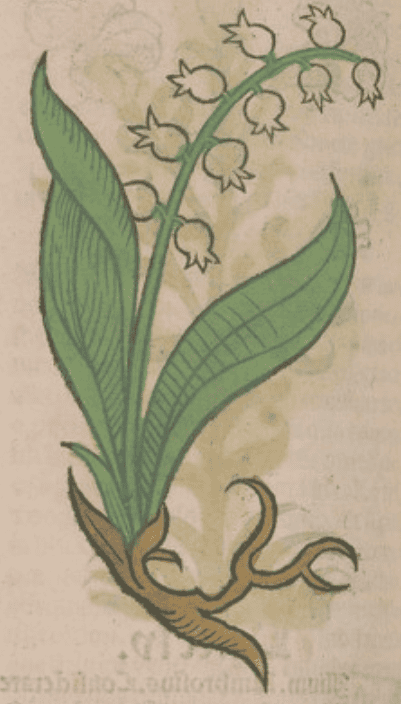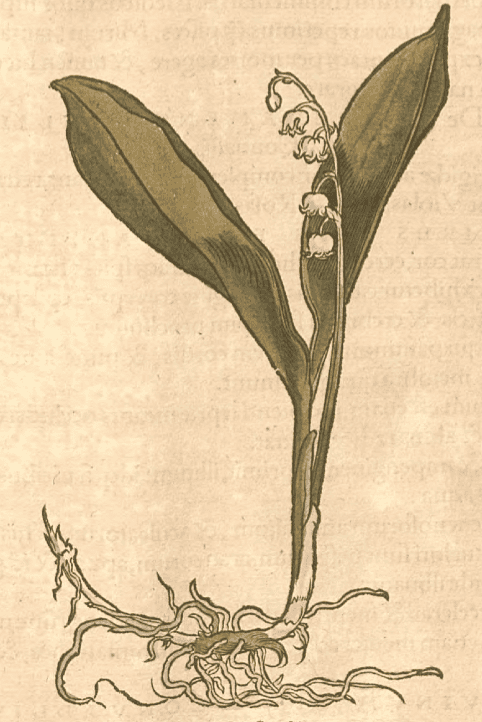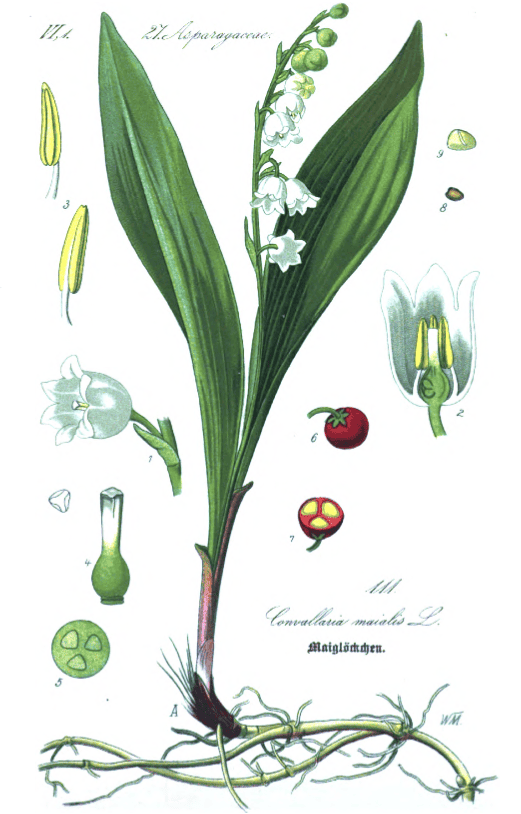Convallaria, Lily of the Valley |

|

|

|

|
|
Ortus Sanitatis, Meydenbach, 1491 |
Herbarum Vivae Eicones, Otto Brunfels, 1530 |
 Flora von Deutschland, Kohler, 1886
Flora von Deutschland, Kohler, 1886 Dried Root
Dried RootNotes on Pharmacognosy, Otto Augustus Wall, 1902
Botanical name:
Convallaria majalis
Parts used:
Root, Flower
Temperature & Taste:
Slightly Cool, dry. Bitter, Sweet
Tabernaemontanus classed it as Warm and dry, while such as Lonicerus, classed it as Cool and moist.
Classifications:
3D. CORDIALS & CARDIACS
4c. CARDIAC
TCM:
H. Nourish the Heart
Uses:
1. Nourish the Heart, Calms the Spirit:
-insomnia, palpitations with anxiety, nervousness, melancholy
-benefits Brain, Reasoning and Memory (Tabernaemontanus)
-Flowers are better to calm the mind and spirit, and settle the Heart
2. Moves the Blood, Regulates the Heart:
-Hypertension, palpitations, arrhythmia, arteriosclerosis
-Valvular Heart diseases
-good substitute for Digitalis or Digoxin when poorly tolerated.
-regarded as good to condition the Heart of athletes
3. Settles Wind, Calms the Mind and Nerves, Stops Spasms:
-used for diseases of the Head, Apoplexy, Paralysis, Migraine, Epilepsy, Fainting
-recovery after Strokes; loss of Speech
-good for confusion, amnesia and poor mental clarity
-benefits Memory; strengthens the Brain
4. Externally:
-powdered finely and used as a sneezing powder
-as an ointment for Ulcers, Burns and Scalds
Dose:
1. Traditionally, the distilled water, Spirit, or Decoction in Wine was the preferred mode of use.
2. Begin with lower doses (even 50mg) and increase as needed
3. Generally recommended to take regular breaks in treatment, alternating with other herbs like Hawthorn.
4. Best combined with herbs like Cinnamon, Hawthorn, Motherwort, Valerian etc.
5. Monitor during use for Heart irregularities.
DRIED HERB or ROOT in Powder: 150–500mg (daily maximum 500mg; 450mg according to British schedule)
Tincture (1:8): 0.5–1.2 mls (daily maximum 3.6 ml)
Fluid Extract (1:1) of the Root: 0.5 ml (8 drops)
Main Combinations:
1. Apoplexy, Lily of the Valley with Lavender, Cinnamon, Mace, Galangal, Mistle, Peony
2. Apoplexy, Dizziness, Epilepsy, Lily of the Valley with Peony, Red Coral, Pearl, Amber
3. Epilepsy:
i. Lily of the Valley flower with Lavender, Saffron, Amber, Camphor (Pharmacopee Usuelle, Louvain, 1821)
ii. Lily of the Valley flower with Lavender, Rosemary, Linden flower, Lavender, Nutmeg, Mistletoe, Peony (Dispensatorium medico pharmaceuticum Palatinatus, 1764)
4. Heart disease, Lily of the Valley with Hawthorn
5. Heart weakness:
i. following Fever, Lily of the Valley with Cinchona
ii. Lily of the Valley with Bugle, Motherwort, Hawthorn berry
6. Heart Arrhythmia:
i. Lily iof the Valley, Hawthorn, Motherwort
ii. Lily of the Valley, Sage, Saffron
7. Palpitations:
i. Lily of the Valley with Lavender, Valerian
ii. Lily of the Valley with Pulsatilla, Hawthorn
8. To promote Urine, Lily of the Valley with Juniper berry, Broom tops
9. Sneezing Powder:
i. Lily of the Valley flower with Orris
ii. Lily of the Valley flower with Orris, Marum, Marjoram
iii. Lily of the Valley flower with Marjoram and Cubeb
iv. Lily of the Valley flower with White Hellebore, Marjoram, Basil, Tobacco, Licorice, Cinnamon
v. Betony, Rosemary Sage, Lavender, Lily of the Valley flower, Rose, White Mustard, Clove
Cautions:
1. Toxic in overdose.
2. Not used in Pregnancy
Main Preparations used:
Distilled Water of the Flowers, Conserve of the Flowers, and an Infused Oil of the Flowers
1. Conserve of the Flowers:
i. Flowers (1 part), White Sugar (3 parts). Beat and mix well.
